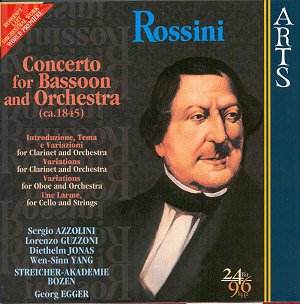Bassoon concertos are not so common that we can ignore
recordings of new ones, even a concerto with as confusing a provenance
as the one with which this disk opens. In 1868 a priest called Giuseppi
Gregiati made a collection of manuscripts (now in the library at Ostiglia,
near Mantua) which included a concerto for bassoon and orchestra which
he attributed to Rossini. The concerto appears to date from between
1842 and 1845 which is the period when Rossini was in Italy, acting
as advisor to the Music School in Bologna. One of the pupils from this
period was bassoon player Nazzareno Gatti. One of Gatti’s obituaries
in 1893, stated that Rossini wrote him a Bassoon Concerto. The manuscript
itself is littered with annotations, which has caused some scholars
to attribute the concerto to a collaborative effort between Rossini,
Gatti and Domenico Liverani (a teacher at the Bologna Music School).
It is notable that neither Bruno Cagli of the Fondazione Rossini, nor
the Rossini scholar Philip Gossett have endorsed the attribution. If
it truly is by Rossini, then the work has another attraction besides
being one of his rare orchestral works. In the 1840s Rossini virtually
stopped composing. His late works all date from the period after 1855
when he returned to Paris. So the concerto would represent a unique
example of a ‘late - middle period’ Rossini, coming after the operas
but before the ‘Petite Messe Solennelle’ and the ‘Sins of Old Age’.
Whoever wrote it, the concerto was probably written
for Gatti’s final examinations and consists of three contrasting movements
in diverse keys, with suitable opportunities for virtuoso display in
the first and last movements. In 1994, the concerto was edited for publication
by the bassoon player Sergio Azzolini, so it is fitting that he is the
soloist for this, the work’s first recording. It is not a long work,
just over 16 minutes in total, opening with a lively Allegro (the work’s
longest movement) and finishing with a Rondo Allegretto with a lyrical
Largo as the work’s middle movement.
The CD is completed by two early works for Clarinet
and Orchestra, the ‘Variations in C’ and the ‘Introduction, Theme and
Variations for Clarinet and Orchestra’ (the Variations are also heard
in a version of Oboe and orchestra), and finally a concertante work
for Cello and Strings, ‘Une Larme, thème et variations’. This
group of concertante works virtually spans Rossini’s entire composing
career. The two clarinet works date from 1810, the period of his first
operas and the cello piece was written originally for Cello and Piano
and published the ninth volume in the late ‘Sins of Old Age’, it was
arranged in its present form by Giovanni Sollima.
In the bassoon concerto, Sergio Azzolini has an attractive
warm tone and is fully equal to the display passages in the work. The
orchestration takes great care that the solo bassoon is not covered
and generally the full orchestra is reserved for the ritornelli and
the orchestra interruptions. The orchestral contributions from the Streicher-Akademi
Bozen, under their founder Georg Egger, retain the work’s fragile charm.
In style, the work displays something of that ‘Weber goes to Italy’
type charm which is also a feature of the two clarinet works on the
disk. Sergio Azzolini has a sure grasp of the style, wit and charm play
an important part, and there were a number of moments which made me
smile. In the central Largo, with its singing melodies, Azzolini plays
with a beautiful mellifluous tone.
In all the works on this disk, you feel that the opera
house is not far away, Rondo or Theme and Variation form are the two
main structural devices. This bassoon concerto is a charming work. Don’t
expect a full blown romantic concerto, its more like a short scene from
an opera with three contrasting arias. But it is none the worse for
that and it is full of melodic charm.
The two early concertante works for Clarinet are more
well known and are available on a number of recordings. The performances
on this disk make acceptable fillers. But the clarinettist (Lorenzo
Guzzanti), though equal to the works considerable virtuoso demands,
has a tone that turns rather hard and shrill in its upper register.
This rather robs the works of the wit and charm, which is their most
attractive quality. The oboist (Diethelm Jonas) provides an efficient
account of the oboe version of the ‘Variations in C’. I felt the both
soloists lacked the right style, giving performances that rarely seemed
to rise above the efficient, though there was never a question of their
ability to play these virtuoso works. But lacking the requisite style,
there are just too many places where the solo part seems to be nothing
but a series of arpeggios.
The opening of the final work on the disk is in a different
world. The slow, romantic introduction to the cello variations is recognisably
from the hand of the composer who had written ‘Guillaume Tell’. It is
a rather more sophisticated work than the preceding clarinet and oboe
works. The slow introduction is a haunting atmospheric piece, followed
by a linking section which is almost a separate movement, leading to
the statement of the theme and the variations. These variations rarely
lapse into the sort of routine passages which can occur in the other
works on the disk. There is ample room for virtuoso display and the
cellist (Wen-Sinn Yang) plays these very attractively as well as providing
a lovely singing tone in the slower opening sections.
Having listened to this disk, I do wonder quite how
much Rossini is in the Bassoon Concerto, but it is a charming work none
the less. This disk is work acquiring for this work and the cello variations,
but there are very much charming sidelines from a composer whose main
attention was very firmly elsewhere.
Robert Hugill


